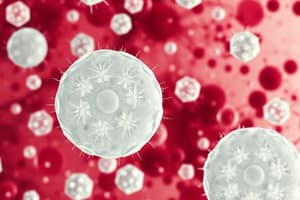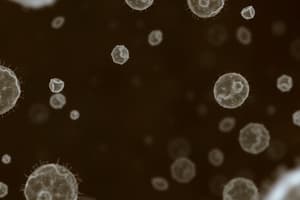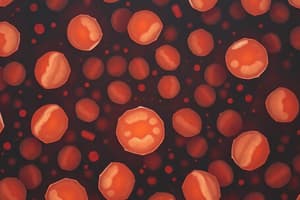Podcast
Questions and Answers
What is the primary purpose of high-dose chemotherapy in bone marrow transplant preparation?
What is the primary purpose of high-dose chemotherapy in bone marrow transplant preparation?
- To stimulate bone marrow production
- To enhance the patient's immune response
- To eradicate diseased bone marrow (correct)
- To treat existing infections
What is the first sign of graft versus host disease (GVHD) that a patient may exhibit?
What is the first sign of graft versus host disease (GVHD) that a patient may exhibit?
- Nausea
- Weight loss
- Fever
- Rash (correct)
What is a critical nursing priority during the care of a patient post-bone marrow transplant?
What is a critical nursing priority during the care of a patient post-bone marrow transplant?
- Monitoring for dizziness
- Evaluating pain levels
- Checking respiratory rate
- Assessing for signs of infection (correct)
In a scenario of bone marrow harvesting, from which parts of the body is bone marrow typically collected?
In a scenario of bone marrow harvesting, from which parts of the body is bone marrow typically collected?
What condition was H.J diagnosed with before presenting with new symptoms?
What condition was H.J diagnosed with before presenting with new symptoms?
What is a major characteristic of Myelodysplastic Syndrome?
What is a major characteristic of Myelodysplastic Syndrome?
What is the primary cause of death in individuals with leukemia?
What is the primary cause of death in individuals with leukemia?
Which type of lymphoma is characterized by the presence of Reed Sternberg cells?
Which type of lymphoma is characterized by the presence of Reed Sternberg cells?
What is the significance of the Philadelphia Chromosome in leukemia?
What is the significance of the Philadelphia Chromosome in leukemia?
What type of cells are overproduced in Multiple Myeloma?
What type of cells are overproduced in Multiple Myeloma?
A key urinary marker for Multiple Myeloma is the presence of which protein?
A key urinary marker for Multiple Myeloma is the presence of which protein?
Which of the following findings would most likely indicate acute myeloblastic leukemia (AML)?
Which of the following findings would most likely indicate acute myeloblastic leukemia (AML)?
What is a common characteristic symptom of lymphoma?
What is a common characteristic symptom of lymphoma?
Which type of anemia is characterized by an overproduction of bone marrow?
Which type of anemia is characterized by an overproduction of bone marrow?
What is the most common type of anemia associated with small cell size?
What is the most common type of anemia associated with small cell size?
Which immune cell is responsible for selectively attacking and destroying non-self cells?
Which immune cell is responsible for selectively attacking and destroying non-self cells?
Tumor Lysis Syndrome is characterized by the release of what into the bloodstream?
Tumor Lysis Syndrome is characterized by the release of what into the bloodstream?
What is a common treatment approach for Polycythemia Vera?
What is a common treatment approach for Polycythemia Vera?
Which cell type is primarily involved in allergic reactions?
Which cell type is primarily involved in allergic reactions?
What does a Bone Marrow Biopsy typically require in terms of procedure?
What does a Bone Marrow Biopsy typically require in terms of procedure?
Which type of cell is involved in the non-specific attack of mutated and malignant cells?
Which type of cell is involved in the non-specific attack of mutated and malignant cells?
What is the primary concern for the nurse when the patient returns after the central venous catheter insertion?
What is the primary concern for the nurse when the patient returns after the central venous catheter insertion?
Which of the following is an expected adverse effect of idarubicin?
Which of the following is an expected adverse effect of idarubicin?
What laboratory values should the nurse monitor closely for during chemotherapy treatment?
What laboratory values should the nurse monitor closely for during chemotherapy treatment?
Given the provided vital signs, what nursing action should be taken first?
Given the provided vital signs, what nursing action should be taken first?
Based on the blood work provided, what blood product is most likely to be ordered?
Based on the blood work provided, what blood product is most likely to be ordered?
Which nursing intervention is most appropriate to monitor the patient's status during chemotherapy?
Which nursing intervention is most appropriate to monitor the patient's status during chemotherapy?
What is the safest approach regarding the administration of cytarabine?
What is the safest approach regarding the administration of cytarabine?
What is the major purpose of the induction phase in chemotherapy?
What is the major purpose of the induction phase in chemotherapy?
What common oncologic emergency is H.J. experiencing based on his lab values?
What common oncologic emergency is H.J. experiencing based on his lab values?
Which laboratory result confirms the diagnosis of tumor lysis syndrome?
Which laboratory result confirms the diagnosis of tumor lysis syndrome?
What is a possible neuromuscular clinical manifestation of H.J.'s condition?
What is a possible neuromuscular clinical manifestation of H.J.'s condition?
What renal clinical manifestation is expected in H.J. given his lab findings?
What renal clinical manifestation is expected in H.J. given his lab findings?
What treatment is ordered to manage H.J.'s condition effectively?
What treatment is ordered to manage H.J.'s condition effectively?
Which lab finding indicates the need for emergency intervention concerning potassium levels?
Which lab finding indicates the need for emergency intervention concerning potassium levels?
What sign may present in H.J. due to hypocalcemia?
What sign may present in H.J. due to hypocalcemia?
Which medication is specifically administered to help lower uric acid levels?
Which medication is specifically administered to help lower uric acid levels?
Flashcards
Anemia Classification
Anemia Classification
Anemia is categorized by red blood cell size: microcytic (small), normocytic (normal), and macrocytic (large).
Microcytic Anemia Cause
Microcytic Anemia Cause
Iron deficiency is the most common cause of microcytic anemia.
Polycythemia Vera Cause
Polycythemia Vera Cause
Overproduction of bone marrow cells (different from secondary polycythemia).
Polycythemia Vera Effect
Polycythemia Vera Effect
Signup and view all the flashcards
Polycythemia Vera Monitoring
Polycythemia Vera Monitoring
Signup and view all the flashcards
Polycythemia Vera Treatment
Polycythemia Vera Treatment
Signup and view all the flashcards
WBC Differential - Neutrophil
WBC Differential - Neutrophil
Signup and view all the flashcards
WBC Differential - Monocyte
WBC Differential - Monocyte
Signup and view all the flashcards
Bone marrow transplant complications
Bone marrow transplant complications
Signup and view all the flashcards
What is myeloablative therapy?
What is myeloablative therapy?
Signup and view all the flashcards
Graft-versus-host disease (GVHD)
Graft-versus-host disease (GVHD)
Signup and view all the flashcards
What are the common GVHD symptoms?
What are the common GVHD symptoms?
Signup and view all the flashcards
What medications are used for GVHD?
What medications are used for GVHD?
Signup and view all the flashcards
Myelodyslastic Syndrome
Myelodyslastic Syndrome
Signup and view all the flashcards
Pancytopenia
Pancytopenia
Signup and view all the flashcards
What are common nursing interventions for thrombocytopenia?
What are common nursing interventions for thrombocytopenia?
Signup and view all the flashcards
What are common nursing interventions for leukopenia?
What are common nursing interventions for leukopenia?
Signup and view all the flashcards
What's the difference between acute and chronic leukemia?
What's the difference between acute and chronic leukemia?
Signup and view all the flashcards
What are blasts?
What are blasts?
Signup and view all the flashcards
What is the Philadelphia Chromosome?
What is the Philadelphia Chromosome?
Signup and view all the flashcards
What are the major features of lymphoma?
What are the major features of lymphoma?
Signup and view all the flashcards
Central Venous Catheter Insertion: Risk
Central Venous Catheter Insertion: Risk
Signup and view all the flashcards
Cytarabine (Ara-C) Side Effects
Cytarabine (Ara-C) Side Effects
Signup and view all the flashcards
Idarubicin (Idamycin) Side Effect
Idarubicin (Idamycin) Side Effect
Signup and view all the flashcards
Chemotherapy Side Effects: Nursing Actions
Chemotherapy Side Effects: Nursing Actions
Signup and view all the flashcards
Fever in Chemotherapy Patient
Fever in Chemotherapy Patient
Signup and view all the flashcards
Blood Cultures: When to Order
Blood Cultures: When to Order
Signup and view all the flashcards
Chemotherapy-Induced Neutropenia
Chemotherapy-Induced Neutropenia
Signup and view all the flashcards
Blood Products for Neutropenia
Blood Products for Neutropenia
Signup and view all the flashcards
What is Tumor Lysis Syndrome?
What is Tumor Lysis Syndrome?
Signup and view all the flashcards
What lab values confirm TLS?
What lab values confirm TLS?
Signup and view all the flashcards
What clinical manifestations indicate TLS?
What clinical manifestations indicate TLS?
Signup and view all the flashcards
What is the role of IV fluids in TLS treatment?
What is the role of IV fluids in TLS treatment?
Signup and view all the flashcards
How does furosemide (Lasix) help with TLS?
How does furosemide (Lasix) help with TLS?
Signup and view all the flashcards
Why administer sodium bicarbonate in TLS?
Why administer sodium bicarbonate in TLS?
Signup and view all the flashcards
What is the purpose of allopurinol in TLS?
What is the purpose of allopurinol in TLS?
Signup and view all the flashcards
Why is Kayexalate given in TLS?
Why is Kayexalate given in TLS?
Signup and view all the flashcards
Study Notes
Altered Hematologic Function
- Conditions: Anemia, Polycythemia Vera, Myelodysplastic Syndrome, Leukemia, Multiple Myeloma, Lymphoma, Tumor Lysis Syndrome, Idiopathic Thrombocytopenic Purpura
Normal Ranges (Hematology)
- WBC Count: 4,000-10,000 /mm3
- RBC Count: 4.5-6.0 mil/mm3
- Hemoglobin: 14-18 g/dL
- Hematocrit: 40-50 %
- MCV: 82-98 fL
- MCH: 27-31 pg
- MCHC: 32-36 g/dL
- RDW-CV: 11-16 %
- Platelets: 140,000-450,000 /mm3
- Differential Count (values vary): Neutrophils (40-75%), Lymphocytes (15-45%), Monocytes (2-12%), Eosinophils (1-6%), Basophils (0-1%), Bands (0-3%)
White Blood Cell (WBC) Differential
- Neutrophil: Nonspecific ingestion and phagocytosis
- Monocyte: Maturing into a macrophage, migrating to tissues
- Macrophage: On-site ingestion and phagocytosis of microorganisms
- Eosinophil: Weak phagocytic action, releasing vasoactive substances for allergic reactions
- Basophil: Releases histamine and heparin
Immunity
- B-lymphocyte: Responds to foreign cells and proteins. Enhances immune activity through cytokine secretion.
- T-lymphocyte: Enhances immune activity through cytokine secretion.
- Plasma cell: Secretes immunoglobulins (antibodies) in response to antigens
- Cytotoxic T-cell: Selectively attacks and destroys non-self cells, including grafts, and transplanted organs
- Natural killer cell: Non-selectively attacks mutated and malignant cells; also attacks grafts and transplanted organs
Bone Marrow Biopsy
- Procedure: Informed consent; sterile technique; local anesthetic necessary, Iliac Crest; pressure and pain during biopsy
- Purpose: Diagnosing blood-disorders and cancers (cancer spreading to a specific site).
Anemia: Cell Size
- Microcytic: Iron deficiency (most common).
- Normocytic: Aplastic anemia (bone marrow failure), Hemolytic anemia (auto-immune).
- Macrocytic: Folate deficiency, B12 deficiency, Pernicious anemia
Polycythemia Vera
- Problem: Overproduction of bone marrow. Different than secondary polycythemia.
- Effects: Increased viscosity > clotting
- Monitoring: Potassium (K+), uric acid levels
- Treatment: Hydration, anti-coagulants, phlebotomy with or without apheresis. JAK2 Mutation.
Myelodysplastic Syndrome
- Description: Not cancer, may be precancerous.
- Effects: Pancytopenia (Know nursing interventions for thrombocytopenia, leukopenia, anemia)
Leukemia
- Types: Acute or chronic; sudden onset vs. slow onset
- ALL: Most commonly seen in children.
- AML: Acute Myeloid Leukemia
- CLL: Chronic Lymphocytic Leukemia
- CML: Chronic Myeloid Leukemia
- Blasts are baby cells: Overproduction of dysfunctional, immature WBCs (blasts) overwhelming production of RBCs and platelets. Infection is a frequent cause of death.
- Philadelphia Chromosome: Marker in certain leukemias (ALL and CML)
Lymphoma
- Description: Cancer of the lymphatic system.
- Hodgkin's Lymphoma: Characterized by Reed-Sternberg cells.
- Non-Hodgkin's Lymphoma: Sub-categorized as.B-cell or T-cell
Multiple Myeloma
- Problem: Overproduction of dysfunctional cancerous plasma cells
- Effects: Interferes with normal RBC, WBC and platelet production
- Plasma cells in anatomy: Important for antibody production
- Bence Jones Protein: Presence in urine, consistent with Multiple Myeloma
Tumor Lysis Syndrome (TLS)
- Association: Associated with Chemotherapy
- Consequences: Hyperuricemia, Hyperphosphatemia, Hyperkalemia, Acute renal failure, arrhythmias, death
Bone Marrow Transplant
- Description: Harvesting bone marrow from a donor (patient's brother here). Stem cells are retrieved (removed) for transplant.
- Procedure: High-dose chemotherapy / myeloablative therapy to wipe out affected bone marrow. New marrow will be induced via central venous catheter
- Time: 14-21 days to engraft and produce new marrow
Nursing Priorities
- Infection
- Bleeding
- Organ rejection: Immunosuppressant therapy may be needed to prevent graft vs host disease (GVDH); cyclosporine, corticosteroids, methotrexate
Case Studies
- Case Study 1: A 43-year-old female, diagnosed with Acute Myeloblastic Leukemia (AML) from a rash, joint pain, epistaxis, bleeding gums, and fatigue. CBC reports 39,000 WBCs, 64% neutrophils, 4% monocytes, 17% blasts (indication for AML).
- Case Study 2: A 46-year-old male, diagnosed with non-Hodgkin lymphoma months prior experiencing malaise, muscle weakness, night sweats, and palpitations, and is presenting with new symptoms of metastatic disease in liver and spleen (potentially representing a complication). CBC reports 1,500 WBCs, 66% neutrophils, 16% lymphocytes, 15% monocytes, and 5% eosinophils.
Labs: CBC Results
- Multiple laboratory values are listed for a complete blood count (CBC) for both patients. Some are abnormal and critical, in Case Study 1 and Case Study 2
Labs: Metabolic Panel Results
- Specific lab results for various metabolites in blood. Specific results are noted including abnormal levels of various metabolites
Clinical Markers
- Reed Sternberg Chromosome: Specific to Hodgkin's lymphoma.
- Philadelphia Chromosome: Linked to specific leukemias.
- Bence Jones Protein (urine): Specific to Multiple Myeloma.
Studying That Suits You
Use AI to generate personalized quizzes and flashcards to suit your learning preferences.




